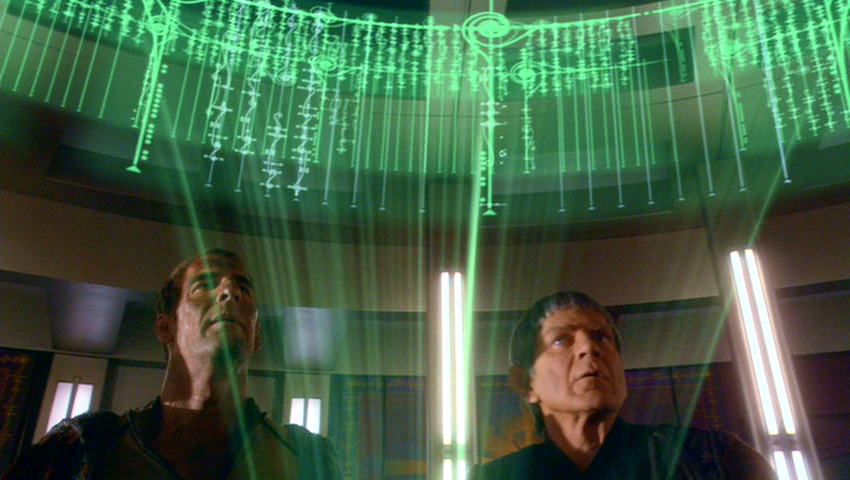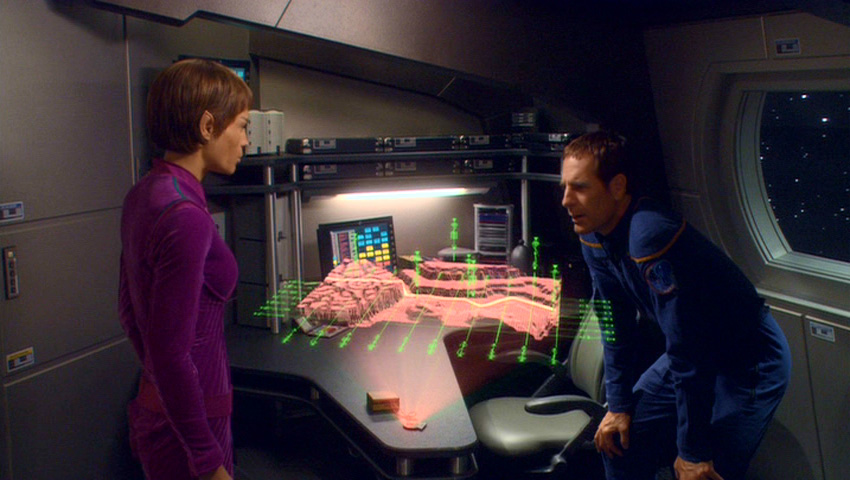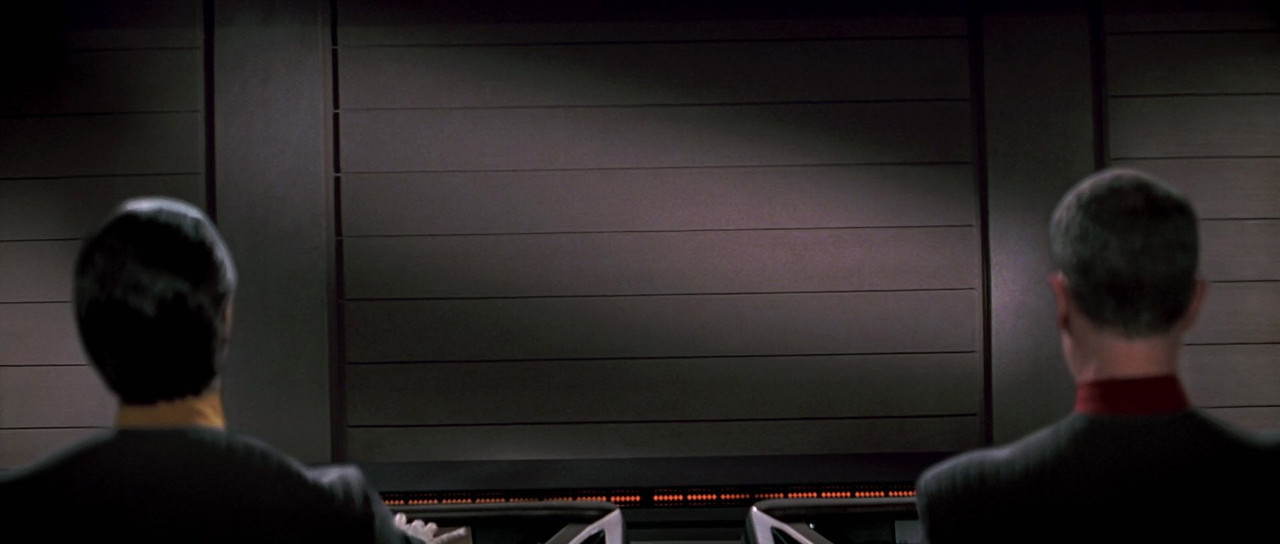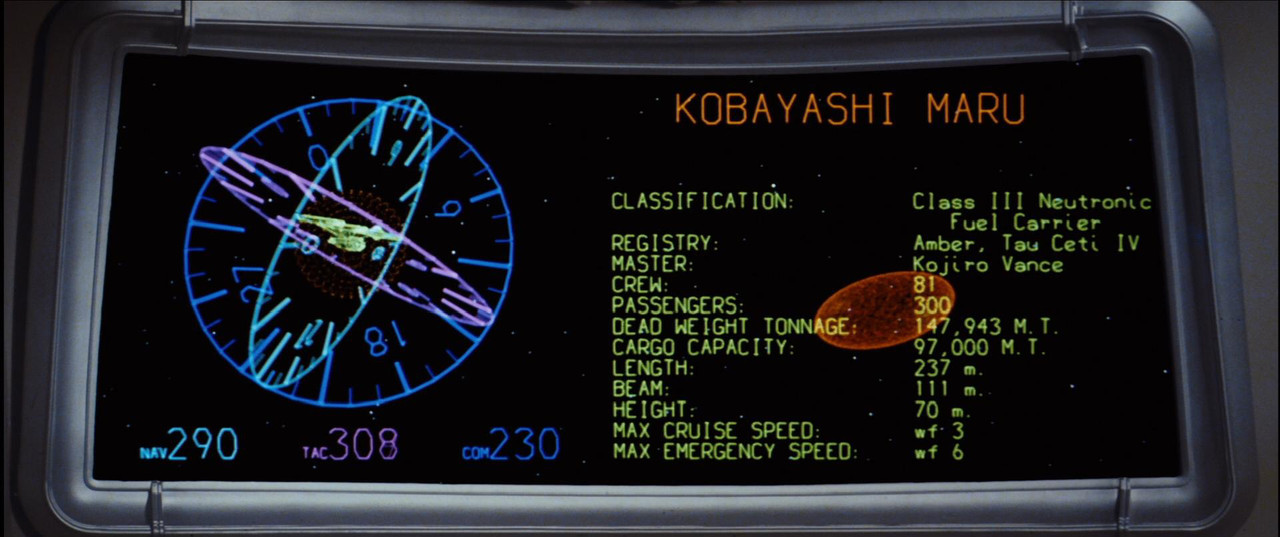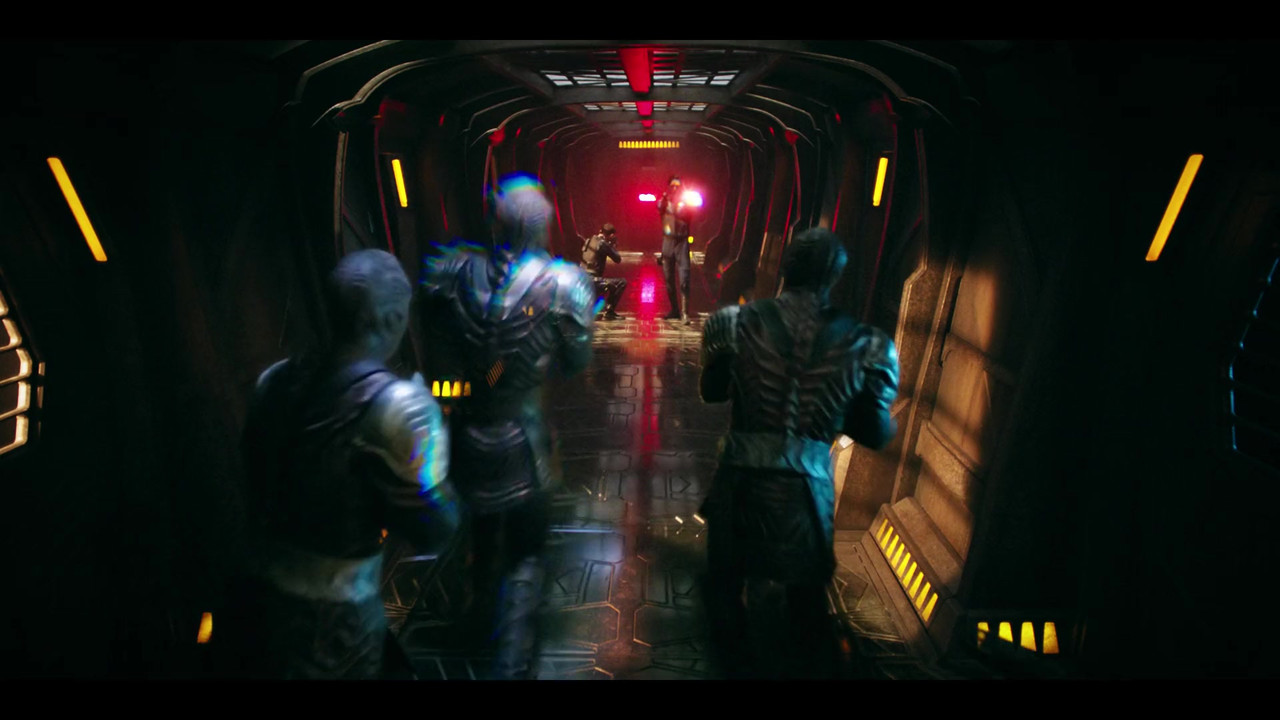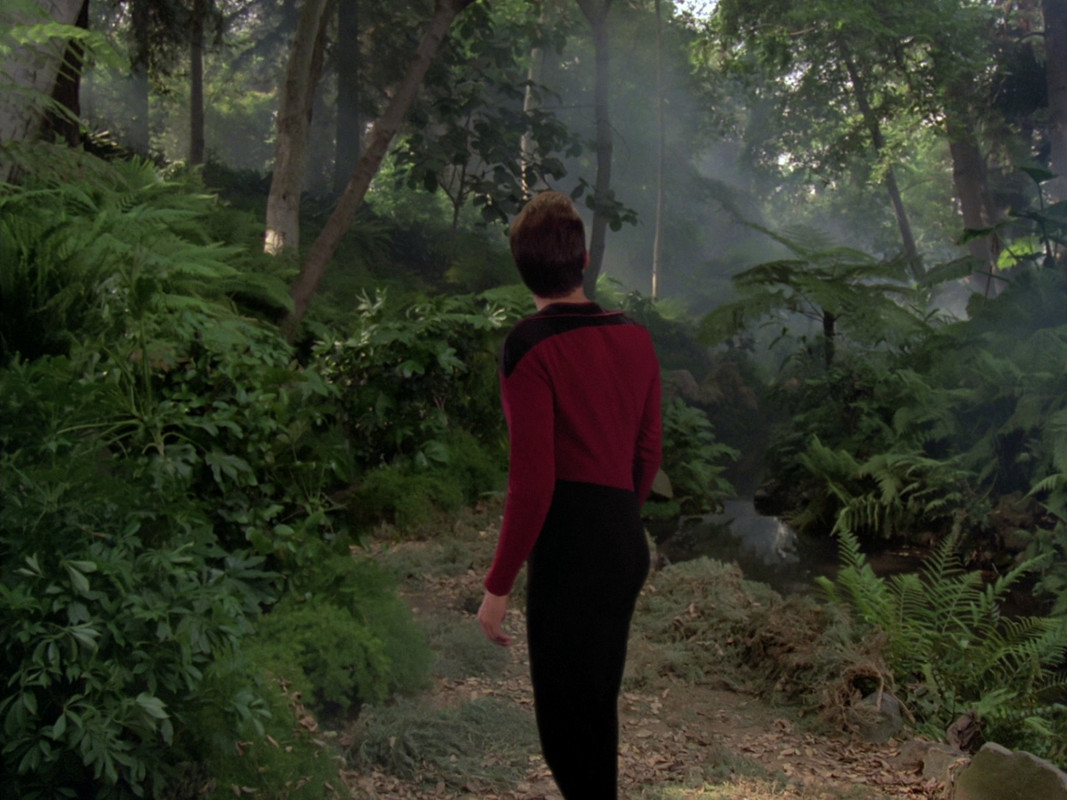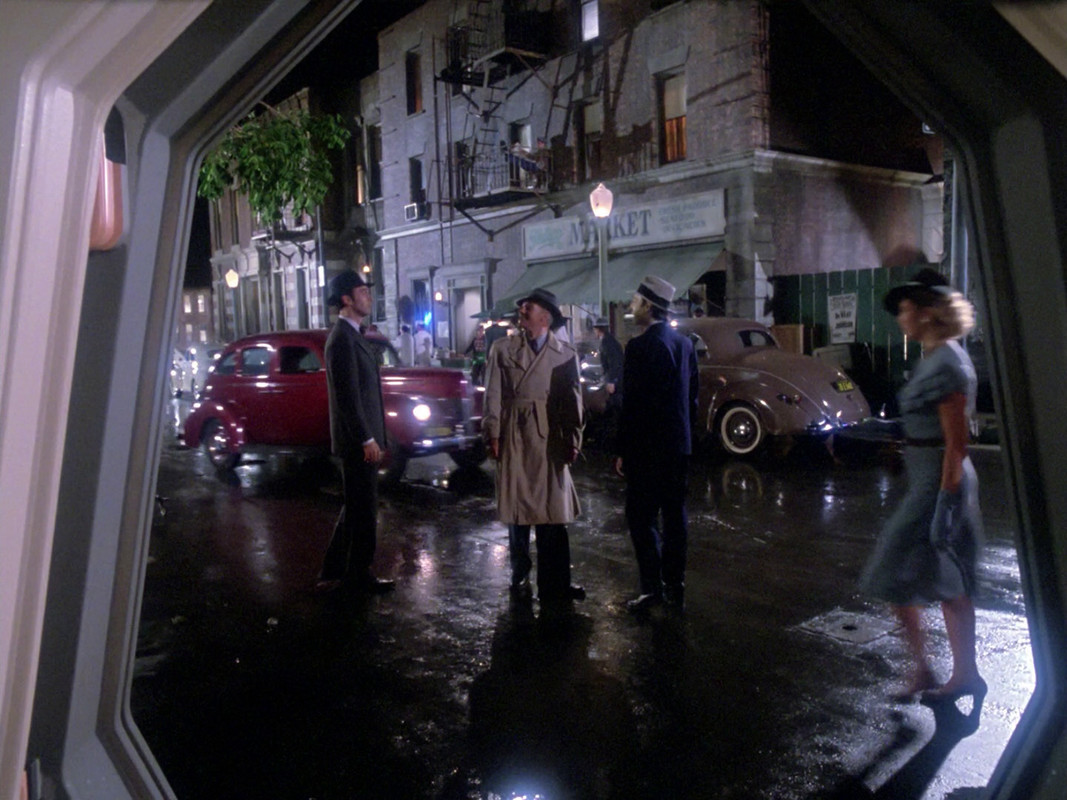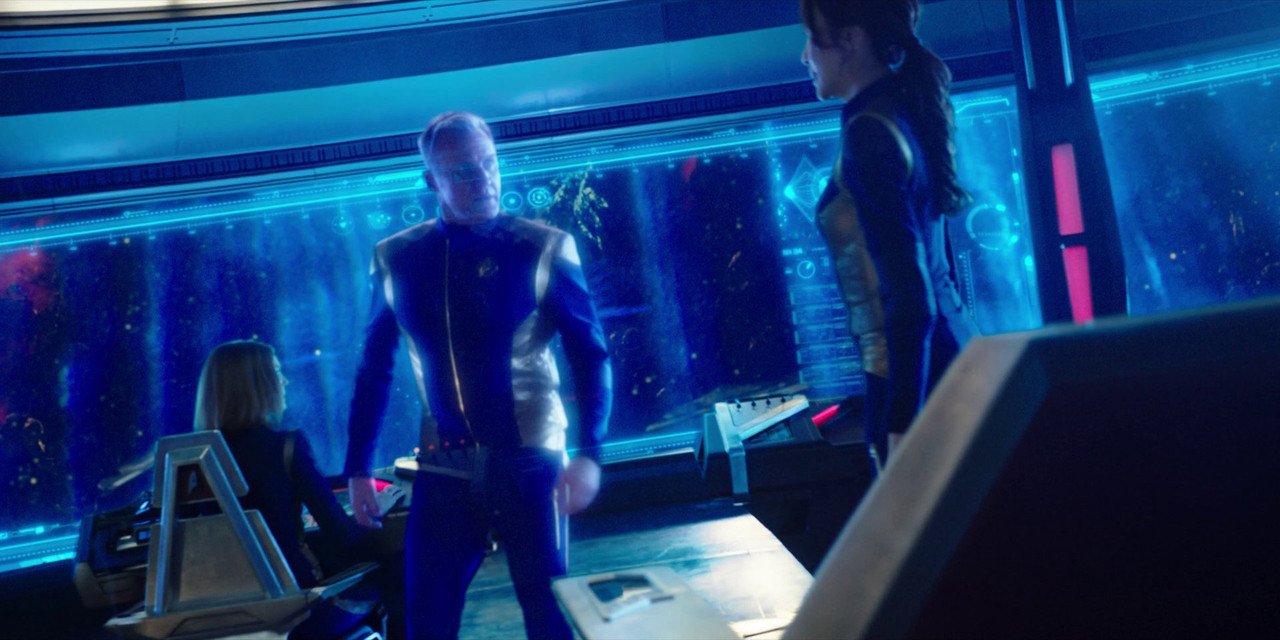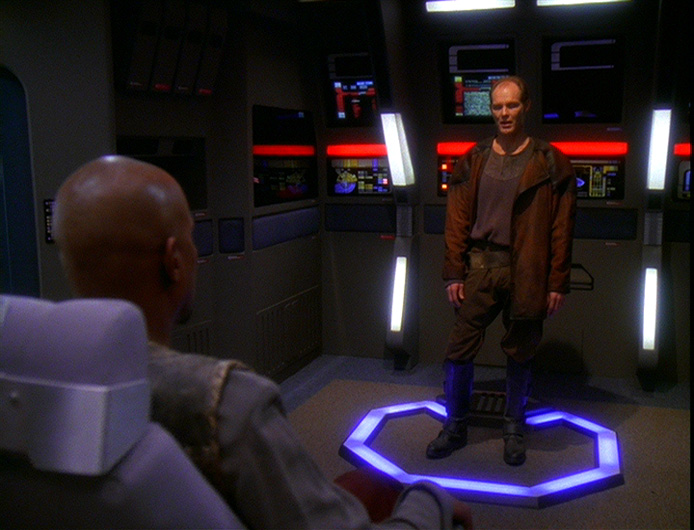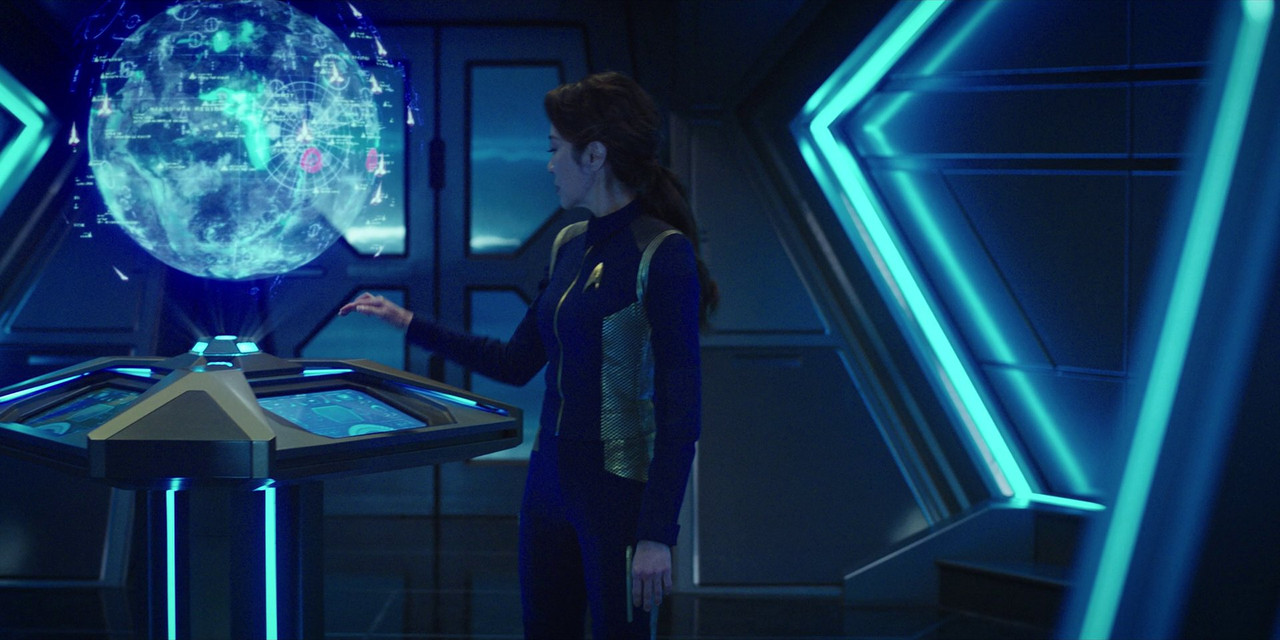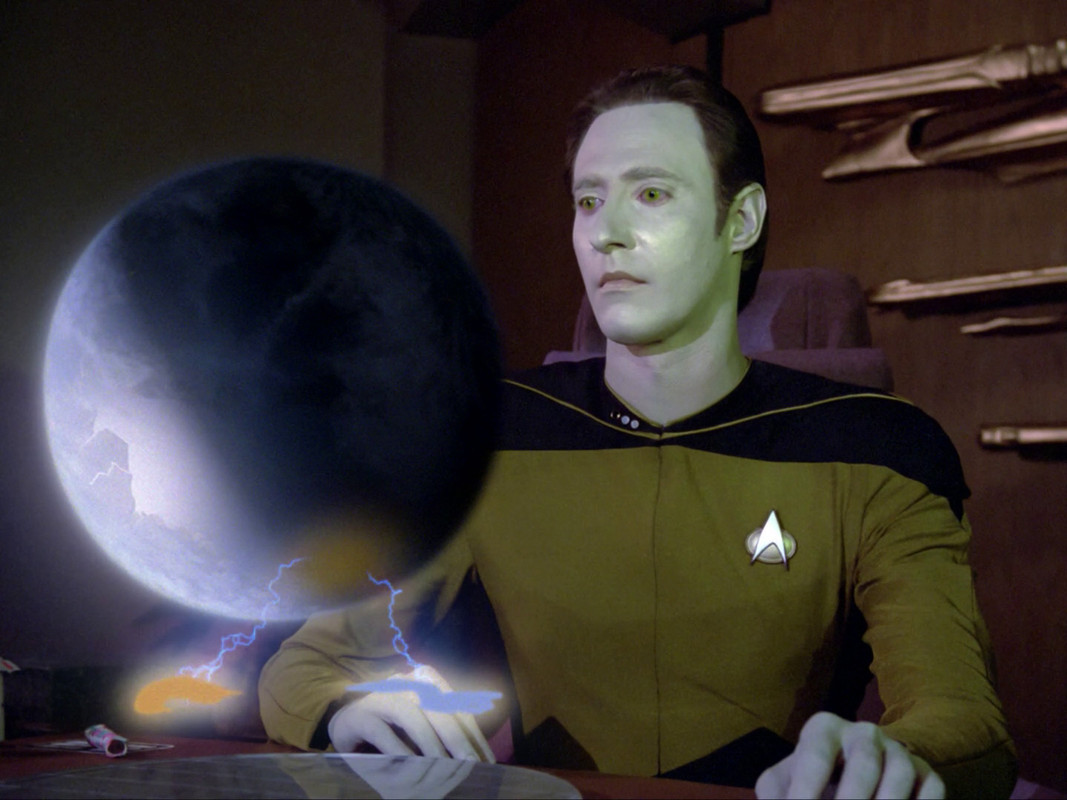I appreciate
@Locutus of Bored allowing me the opportunity to post this, most of which I had already typed up before the thread was locked and didn't want to simply disappear into the aether. My intention here isn't merely to bicker and prolong a futile argument, but to address some specific points raised. If it has the former effect, I apologize to all concerned.
Personally I find this the most convincing argument: Enterprise episode "The Seventh" shows 22nd century vulcan holographic technology similar to communication holographic technology shown on Discovery
Like I said, had 'em since Surak...
To play the devil's advocate for a moment, though, nothing in "The Seventh" (ENT) necessarily implied that trinket was Vulcan technology. Menos could have gotten it from his wife's people (hey wait, was that even
really his family at all, or was it all a ruse?) or another species he'd encountered in his travels. So I'm not sure why you'd view it as a more "convincing argument" than the above.
Taken in isolation, I suppose the examples from the "Kir'Shara" (ENT) trilogy might be argued to be supertech lost to wider Vulcan through the wars in which their
"planet was devastated" and their
"civilization nearly destroyed" and only rediscovered later. It
was interesting that the T'Karath Sanctuary seemed to have holographic camouflage that functioned just fine in the Forge, where other contemporary Vulcan technology apparently did not, after all. (But then, maybe the sanctuary was simply tucked away in a natural pocket of calm amid the raging sea of geomagnetic instabilities. And while T'Pol and Archer were surprised by the fact that the IDIC contained a map, they didn't seem to find the holography itself particularly worthy of remark. And even if they had, the following century leading up to DSC might still have been enough time for such tech to have propagated.)
But the simple fact of the matter is that the technology shown on Star Trek Discovery looks more advanced and commonplace than what we've seen on any other star trek series.
To the extent that's true, it's primarily the result of more advanced technology having become more commonplace in real life, and thus available to be utilized by film and television productions. TOS looked as it did because it was created with 1960s technology, with an eye toward 1960s aesthetics, and with the intent of being shown on 1960s television screens. The same goes for TNG in the 1980s, DS9 and VGR in the 1990s, ENT in the early 2000s, and DSC today. What we see in any given
artistic portrayal of the fictional
Trek world tends to represent rather more the limits of what its makers were able to conceive of and realize within their allotted time and budget, using the resources they had at hand, and to the dramaturgic effect desired in context of a given plot, than it does those of what is possible to imagine in-universe.
As I know I've pointed out before in these discussions,
The Making Of Star Trek documents that Roddenberry envisioned Kirk's
Enterprise as being equipped with holographic accoutrements and dispensing reconstituted clothing all along:
MEN AND WOMEN ON A STARSHIP, SO LONG OUT OF CONTACT WITH EARTH AND SO LONG AWAY FROM OTHER PLANETS, TOO, WILL REQUIRE A FEELING OF FRESH AIR AND SKY AND WIND AND SCENTS. BECAUSE WE ARE, IN MANY RESPECTS, STILL ANIMALS, OUR MENTAL AND EMOTIONAL EQUILIBRIUM WILL REQUIRE THE FAMILIARITY OF THIS. MAN HAS BEEN TOO LONG A PART OF EARTH TO BE TOO LONG SEPARATED. THEREFORE WE INTEND TO BUILD A SIMULATED 'OUTDOOR' RECREATION AREA WHICH GIVES A REALISTIC FEELING OF SKY, BREEZES, PLANTS, FOUNTAINS, AND SO FORTH. ONE OF THE REASONS FOR MAKING A STARSHIP SO LARGE WOULD BE TO HAVE SOMETHING LIKE THIS...
The fourth major facility on the eighth deck level is the entertainment center. Certainly man of the future will require entertainment as much as we enjoy motion pictures and television today. Probably entertainment will be three-dimensional in nature and perhaps will go even further, in that you will sit in the room and the story will take place all around you. In other words, a sophisticated extension of holography.
This technique will also have its effect on the traditional "mail call." Instead of receiving a letter, a man can sit in the room and, via tape, actually "see" the person sending the correspondence. As the tape is projected, the images will form in the air in front of him, so he will be able to see how his child looks, what's happening to the house, and how great his grandmother looked that day. It will be just as if he were standing there with them. Having used the "projecting unit," he can then use the "photographing unit," do a similar thing himself, and send it home...
Ship's laundry bears little resemblance to its 20th century ancestor. Primarily because garments are reconvertible. It is simply easier to put a garment into the processing machine, reduce it to its original chemical fibers, take out the dirt, and then recreate a "new" garment back into its original form...
And per the
Deep Space Nine Companion, when Ronald D. Moore added holo-communicators to DS9, his reasoning was as follows:
That's something I had been pushing for because I just think it's so absurd that in the twenty-fourth century they have holodeck technology that allows them to recreate Ancient Rome, but everybody talks to each other on television monitors. It's just so lame. The viewscreens have been around for over thirty years. Can't we move to something a little more interesting? But it's like pulling teeth...
Of course, the TNG viewscreens were never actually meant to be simple "television monitors" anyway. They were holographic displays with depth, as can be seen when the perspective within the image changes with the camera angle:
"Year Of Hell, Part II" (VGR) even shows us the holo-grid behind the magic:
We might imagine such advances in viewscreen technology to be the very development that eventually rendered the window component seen on earlier vessels obsolete. Or indeed, by the time the
Enterprise-E was launched, rendered even the
screen itself superfluous:
This.
And endless examples like Riker's amazement when he walks into the holodeck in "Encounter at Farpoint" when Ash and Lorca were in a Klingon ship simulation that looked just as real...
But Riker isn't amazed merely because it
looks real. He's amazed because it
feels real (and again, much of it
is real). And "feeling real" is a criterion that basically has no objectively definable upper limit, because it's a subjective one. What basis do we have to judge
how real that combat exercise in "Lethe"
feels for Ash and Lorca compared to how real that forest in "Farpoint" feels for Riker? Or how real dancing with Zora in "Calypso" feels to Craft compared to how real kissing Jessica Bradley in "Goodbye" feels to Picard? Without being physically in the room with them, what basis do we have to say the amazement we observe in the TNG characters at their "upgrade" (which again, it's explicitly called in "Goodbye") is unwarranted?
Do Burnham's holographic candles give off heat? Does the faint smell of smoke linger in the air after she extinguishes them? When she uses the mirror function, can
she not tell that her reflection is merely a mirage as she stands in front of it? Could Lorca and Tyler have engaged in back-and-forth conversation with those simulated Klingons? Would they each have their own distinct personalities? Could they have been imbued with sentience, like Moriarty in "Elementary, My Dear Data" (TNG)? Could they have taken it upon themselves to alter their own programming, like the EMH? (Without the benefit of a thousand years of emergent evolution or other extraordinary circumstances, that is.)
Ted Sullivan and other DSC writers would seem to
answer in the negative:
Look, they never physically interact with the Klingons. Yes, Tyler “hits a virtual button,” but you do the same thing playing Star Trek: Bridge Crew on the PS4. What you’re seeing here is a step toward the development of holodecks. It’s not a fully realized holodeck.
We talked about this a lot in the room. It’s honestly not that far removed from today’s VR experience. Are we supposed to pretend that technology just disappeared or stopped evolving? This is basically a high tech laser tag. And honestly – it was in The Animated Series. So I don’t get what the big controversy is.
Technology doesn’t just suddenly materialize overnight. You evolve slowly from punchcard machines to desktop computers to laptops to smartphones. What you’re seeing here is a step in the journey of the development of holodecks. That’s all.
Yet even if such answers were to be contradicted as the show goes on, the fact would remain that there's always room for a simulation to improve in verisimilitude, no matter how good it already is, and there's always room for even the subtlest of differences to be of significance to a given user. Remember, as amazed as Riker and Picard are initially, within a few episodes they'll be just as amazed
again when the Bynars kick things up a notch with Minuet in "11001001" (TNG). They recognize a qualitative improvement even though they can't quantify it.
By contrast, the same individuals remain distinctly
unimpressed with certain replicated foods, Riker complaining in "Time Squared" (TNG) that the computer doesn't
"allow for the subtlety needed for great cooking...flair or individuality...what marks the difference between artistry and mere competence," and Picard lamenting of his favorite caviar in "Sins Of The Father" (TNG) that
"our replicator has never done it justice." The devil is in the details, and not just the ones
we as the audience can distinguish onscreen, but also those we
can't. The important thing is, the characters
can. We know they can, because they
tell us so.
When exactly do 24th century characters ever remark upon a hologram simply
looking real? The only example that comes to mind offhand is the new holo-communicator in "For The Uniform" (DS9), which poses no problem, since the old ones we see in DSC obviously
don't. You can see right through them, they flicker, etc. Pike finds them unsettling because they look like ghosts, just as Sanders finds the new ones unsettling because they evoke the impression of uninvited guests. (Nicely illustrating that there will always be people who prefer not to use them even if they're around and available, just like there have always been people who prefer writing letters to making phone calls, or texting to video-chatting, vinyl or cassettes or CDs to MP3s, etc.)
Starfleet technology in the 24th century is more advanced but might be simply more in the background and not so obvious to recognize on first sight.
Like the cities on Earth we saw during the 24th century appear to be even a bit more modest and low tech in comparison to today. We even saw carriages on the streets of New Orleans during "Paradise Lost".
During development of
Phase II and TMP, Roddenberry posited that a lot of industry and transport would have moved underground, with many natural spaces being reclaimed above. That's why the original theatrical version of TMP portrayed San Francisco as it did:
Even though that particular depiction was later supplanted, we might yet imagine that even as that city continued to be built up, the reverse occurred in others (such as, say, Paris).
Only time ships from the future and Tom Paris's warp 10 shuttle were capable of teleporting across the galaxy.
Your implication seems to be that this capability is treated as standard and unremarkable on DSC. It isn't.
Discovery is treated as a totally unique ship, and the spore drive is treated as an extraordinary experimental technology that no other has.
But speaking of teleporting across the galaxy and
Voyager, how do we know the "sporocystian lifeform" known as the Caretaker wasn't connected to the mycelial network?

DS9 "The Visitor" in the mid 25th century
BASHIR: I haven't worked a two-dimensional control panel in a long time. How did we manage?
3D controls are all over the place on Discovery, no biggy
Besides being from a timeline that was ultimately erased, all this comment implies that 2-D controls were eventually superseded. It
doesn't tell us anything about when 3-D controls first arrived on the scene. DSC has both alongside each other. No contradiction there.
The proof is there. But if I point it out you'll explain it away as circumstantial evidence and then claim it's not proof.
TOS "The Day of The Dove"
KIRK: We can't get through the Klingon defences in time, unless. Spock. Intra-ship beaming from one section to another. It's possible?
SPOCK: It has rarely been done because of the danger involved. Pinpoint accuracy is required. If the transportee should materialise inside a solid object, a deck or wall.
SCOTT: Even if it could work, she may be leading you into a trap.
and they do it a bunch of times in discovery.
First of all, they don't do it "a bunch of times" in DSC. They do it a handful of times. In other words,
"rarely." And it's mentioned in "Brother" (DSC) that pad-to-pad is safer and more reliable.
Secondly, you omit important context of the situation at hand in "Day Of The Dove" (TOS). Their minds are being addled by an entity trying to foster and feed off conflict through inducing
"paranoid mania" in their brain waves. Spock and Scotty are simply being paranoid, as the fact that the procedure ultimately works out just fine despite all the pressures of the moment demonstrates. (They could even be completely delusional. Remember Chekov's phantom brother Piotr, who never actually existed at all?)
That you ignore this possibility, which is actually
directly supportable by the story as presented, and yet espouse a theory about laughing gas causing them all to hallucinate the entire existence of the holographic recreation room in "The Practical Joker" (TAS), which is far more of a stretch, is rather bemusing.
TOS "I, Mudd"
MUDD: There is an entire crew aboard. An entire crew of androids. They learn very quickly, Captain. The fact is, I've taken over your whole ship. There's nothing you can do about it.
KIRK: Harry, Harry, you'll never get away with it.
MUDD: Well, who's to stop me?
KIRK: Starfleet.
MUDD: But now, Captain, now I have a ship of my own as fast as any in the fleet, so how will they catch me, eh? Just think of it, laddybuck. Harry Mudd with his own crew of lovelies aboard your vessel. Think about that.
KIRK: I'm trying not to.
Mudd acting like the technology doesn't exist to catch the enteprise (spore drive)
It may well be that the spore drive technology no longer works, or can no longer be used by Starfleet for other reasons, by that point. We have to wait for DSC (and any other show that falls in between) to be
over before we can know the answer (or be left to ponder the lack of one). Indeed, they seem to already be laying the foundations for such a development in the latest episodes.
Also, we know from "Mudd's Women" (TOS) that at some point prior that episode Harry was subjected to psychiatric treatment, which we know from "Dagger Of The Mind" (TOS) can include selective mind-wipes, suppression of memories, or even implantation of false ones. (Again, a speculation arguably better founded in onscreen evidence than yours regarding "The Practical Joker" is.)
Which one looks the most advanced to you:
See above for how the TNG viewscreen is arguably more advanced.
TWOK shows us that such displays can be overlaid onto an external view:
(Sure, it's a simulation there, yet there's no implication it isn't a normal operating function. Rather the opposite, given the nature of the scenario.)
TVH further shows us that transparent displays are no great feat:
which one looks the most advanced:
Burnham's thruster suit looks bulkier. As for the HUDs, why not assume they exist in the later versions, but are simply turned off? Nobody seems to be using them in "Brother" (DSC), after all. (Moreover, the near-fatal malfunction we observe in Pike's pop-up helmet gives us a good reason why they might have returned to being a separate, non-articulated piece of the ensemble.)
But as long as we're playing this game...
Which one looks more advanced?
Which one looks more advanced?
Which one looks more advanced?
I see the appeal in wanting to treat the Trek universe as something consistent and tangible. For the most part, it is remarkably consistent, but there are obviously gaffes you can find not just between different shows but within themselves as well. VOYAGER tried to explain in "Fury" that maneuvering at warp drive was impossible, that you can only go a straight line... despite the fact that we saw ships maneuver at warp dozens of times, and continued to see it done well after the episode.
Vulcan has no moon... until it does, and then doesn't again, and then does again. For the longest time my biggest impression of Vulcan was that it mainly consisted of old temples, deserts, and caves. I don't think it was until I saw ENTERPRISE that I saw an actual city on that planet (before I would see TAS). The silliest was Amanda giving birth in what looked like a cave... I guess hospitals aren't logical?
I'm with your thrust here, but as I've pointed out elsewhere, "Fury" (VGR) actually says nothing of the sort:
JANEWAY: Tom, what's the first thing they teach you about maneuvering at warp?
PARIS: "Faster than light, no left or right." When possible, maintain a linear trajectory. Course corrections could fracture the hull.
The fact that this pat mnemonic is the
"first thing" taught implies that there is much
more to the subject than that. The fact that it is advisable to maintain a straight path
"when possible" implies that not only
isn't it impossible to do otherwise, but that under certain circumstances it's even
unavoidable. The fact that changing course
"could" cause damage to the ship implies not only that it
can be done, if only one is willing to accept that risk, but further that such damage may
not necessarily result if attempted.
Being in the vulnerable position she was, so far from the nearest starbase or other support facility, and always low on power and supplies, it makes perfect sense that Janeway would be especially wary of the proposition.
As for the supposed cave in TFF, we surely shouldn't take that as a literal representation of Spock's birth. It's merely the representation of his mind's eye, the sum of his deepest and darkest insecurities, as even he seems to realize in dismissing its power over him. We know from "Sarek" and "Unification" (TNG) that his father was never actually repulsed by his humanity, but instead
"loved" and
"admired" him for it.
I'm just hoping the season 2 extravaganza deals with nutter Spock escaping the nuthouse and killing three of his doctors. There must be a really great reason that ties up loose ends and explains how Spock would end up on the Federation Flagship (on top of everything else), otherwise any number of youtube complainers will win the day on the argument of whatever it is they're arguing about.
Come now, should we really be so quick to assume that Spock is actually guilty of what he stands accused of having done (or rather doesn't, since he's missing and can't answer the charges)? As others have said, smells like a Section 31 frame job if ever there was one, to me. And even if he were, it would have surely been in a state of mental incapacity or alien influence. Starfleet would hardly be likely to hold that against him.
Never mind this 25% contract thing...
Never mind it indeed, since it was
confirmed not to be a contractual thing at all, but a creative one. And even if part of the motivation
was to sell new toy licenses, that's exactly how we got the tricorder, the IDIC, and the Klingon battlecruiser in TOS!
I want to say that Picard referred to the Ent-E as the flagship as well in one of the movies, but I'm not 100% sure.
Nope.
First Contact even refers to another ship as that, although it was in that situation undoubtedly being used in the more traditional sense of the vessel from which Admiral Hayes was commanding the battle fleet.
The way that guy frames his videos, you'd think holograms didn't exist in TOS era...
Except they did.
It's particularly egregious how he disingenuously edits out Pulaski's reply to Geordi's query in "Elementary, My Dear Data" (TNG):
LaFORGE: Your first visit to a holodeck, Doctor?
PULASKI: Well, one with this level of sophistication...
As for Spock's quarters in DSC, are they really all that much bigger than those Scotty receives aboard the
Enterprise-D (which had additional adjoining rooms at both ends, IIRC) or merely more spartan in their furnishings? In any case, size clearly isn't the only opulence Scotty would recognize in his. The whole aesthetic of TNG was that creature comforts and hominess no longer had to take a backseat to more utilitarian concerns.
-
MMoM




